Created to explain newsstand and direct editions, with helpful instructions for identifying which is which. (Does not have sound.)
Category: case study
CGC Census – A Game for the Thousandth Collector
Imagine a game where 1,000 lucky collectors are awarded prizes from the CGC Census. Winning ticket #1 would receive the best CGC graded copy of Action Comics #1, Detective Comics #27, and Amazing Fantasy #15, but there are thousands of comic book collectors. What prizes would winner #1,000 receive?

Read the full article on GPAnalysis.com here…
CGC Census – Exploring Second Issues – Is it ever better to be second?

Continuing the exploration of the CGC Census, this month the focus is second issues. Most titles see a significant decrease in both the value and the number of CGC submissions for issue #2 when compared to issue #1.
There are 232,766 different comic books graded by CGC on the CGC Census (April 19, 2022). There are 50,048 different comic books graded by CGC are a #1 issue (21.5%). The total number of submissions on the CGC Census is 7,444,146, with 2,159,016 as #1 issues (29%). For #2 issues, 14,592 different comic books have been graded by CGC (6.3%). The total number of submissions on the CGC Census for #2 issues is 318,492 (4.3%).
Read the article here.
CGC Census – Submissions, Average Grades, and 76,832 Dots!
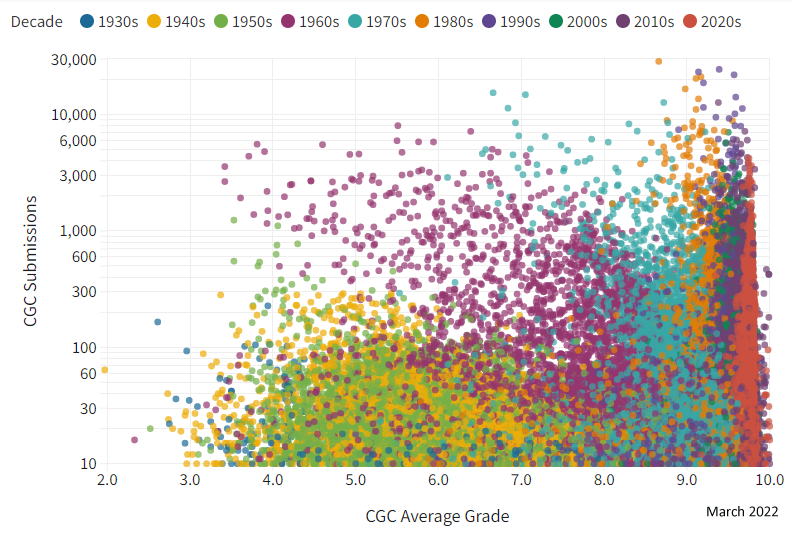
CGC has graded 76,832 issues at least ten times each for a total of 6,835,678 submissions, which represents more than 93% of all CGC submissions. Outliers on a decade color-coded chart show books that “stand out” from the others. Of course books like Amazing Fantasy #15 and Fantastic Four #1 are standouts from the 1960s, but what about other standouts with unusually high average grades?
Explore any of the 76,832 dots, if you have the time, or see a few outlier issues in each decade.
Read the full article online here.
Investing in CGC Graded Comics – Is Higher Grade Better?
It has been said that investing in CGC graded modern books should be CGC 9.8 or nothing. Does that advice hold up to testing? What do 2005 prices look like in 2021? Could the best rate of return be (MUCH) lower on the CGC grading scale? Yes it can!
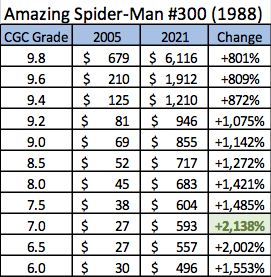
Read the whole article on GPAnalysis.com here.
Newsstand Books – The Way It Was
Before the introduction of the direct market in the late-1970s, every comic book was a “newsstand” edition. Comics published from the 1930s to the late-1970s were all newsstand editions, which meant three things: 1) They could be returned for credit if they didn’t sell by a certain date, 2) They were not ordered according to demand, but according to distributor processes, and 3) both serious and casual comic collectors obtained copies of identical comic books, since all books were newsstand editions.
With the introduction of the direct market, comic book publishers were able to supply comic shops with exactly the number of copies of each book that the retailer purchased. Additionally, in exchange for a discount on the price of each comic book, the direct edition books could not be returned for credit. Comic shop owners could decide which books would sell best, which books would be good to keep in the back issue inventory, and which books they didn’t want to purchase at all.
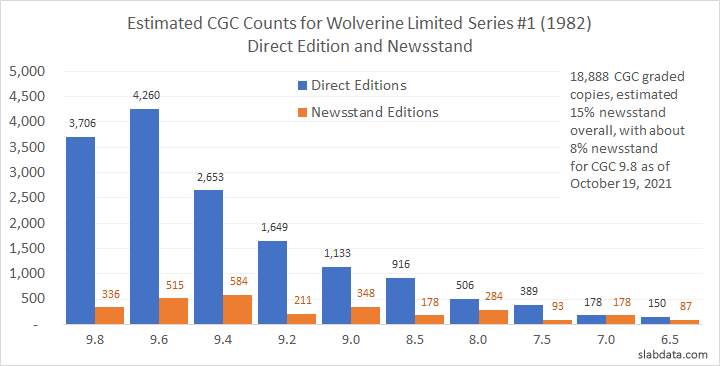
Read the full article for free on GPAnalysis.com.
CGCEMC – CGC Estimated Market Capitalization
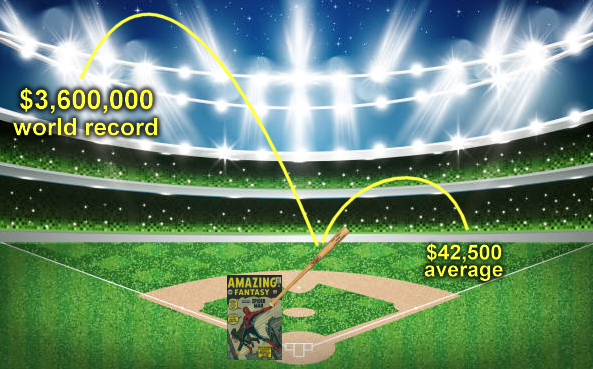
The CGCAMC – Average Market Capitalization introduced in a series of articles during 2020 has been taken to the next step, an Estimated Market Capitalization (EMC) that includes the premiums paid at the highest end of the CGC market. Compare any two comics across ages and genres for their total CGC graded valuation – or at least an estimate that doesn’t take 100 calculations per book.
Read the full article for free on GPAnalysis.com
CGC Average Grades – More Than Meets The Eye?
Can calculating the average universal CGC grade tell us anything about how many copies of the book may still exist? Probably not! But don’t tell that to the first appearances of Superman, Batman, and Robin! Is it just coincidence, or is there a data discovery on the horizon?

Read the whole article for free on GPAnalysis.com here.
Slabbing Comics – CGC Census Retrospective – Decades of Popular Submissions
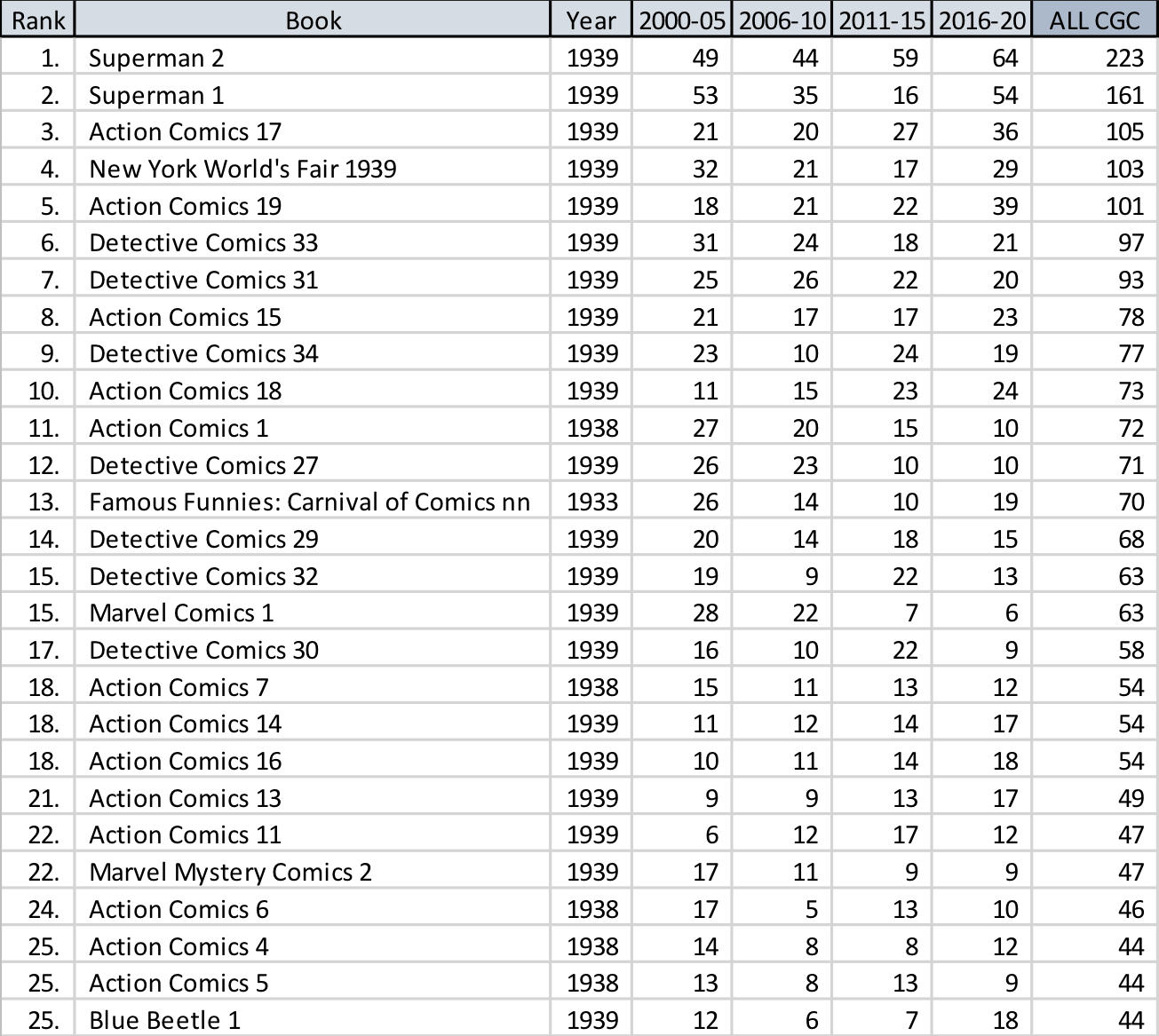
Take a closer look at CGC submissions in five-year blocks over the past 20 years. The latest article in the CGC Census history series breaks the numbers down as Top 25 most submitted by decade from comic books of the 1930s to the 2010s. Action Comics #1 and Detective Comics #27 dominate, right? Not exactly. The CGC Census has fewer copies of those books than you might expect, especially compared to other books of the same age.
Read the full article with Top 25 lists for each decade here.
Slabbing Comics – CGC Census Retrospective – Five Years at a Time
This month’s article steps through time in five-year blocks, looking at the CGC Census for books graded during 2000-2005, 2006-2010, 2011-2015, and 2016-2020. The Top 25 for each of the five-year timeframes do have many of the same books, however, these are separate lists isolating the books graded by CGC during those five-year spans and not a running total since CGC began. The Top 25 for the whole timespan from 2000-2020 is presented at the end of this article.
Starting with the Top 25 CGC Submissions for 2000-2005, the results for the first five years (technically a little over six years, from late 1999 until the end of 2005) have Wolverine Limited Series #1 as the most submitted book to CGC in the timeframe.
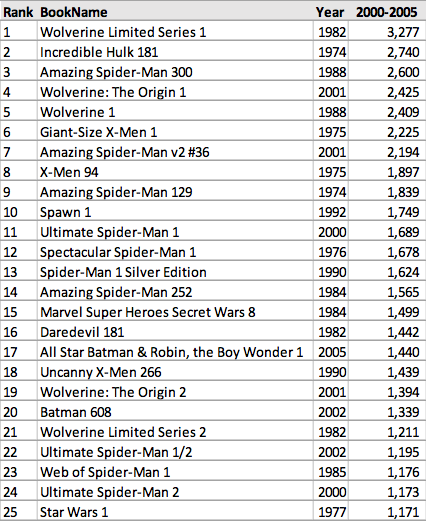
Read the full article for free and see the Top 25 lists on GPAnalysis.com.
Slabbing Comics – CGC Census Retrospective – The First Two Years
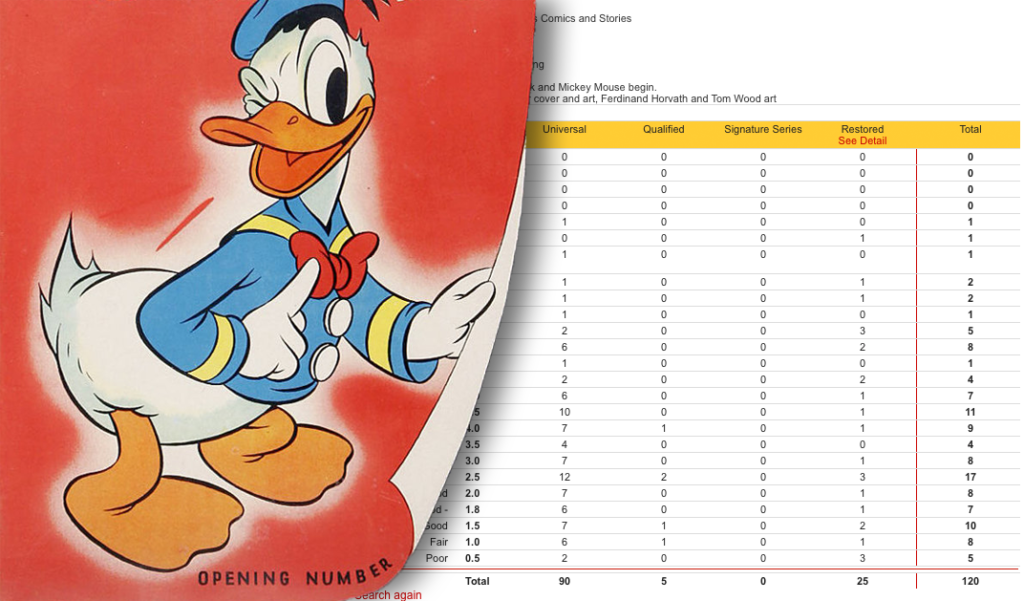
The first CGC graded comic book was Walt Disney Comics & Stories #1 (Dell Publishing, 1940) – CGC Serial #0000001001 (Invoice 0000001, Item 001), originally graded November 9, 1999. CGC opened to the public on January 1, 2000, bringing the “slab” concept from coins and cards to the comic book market.
Take a closer look at CGC’s first 100,000 graded comics.
The first comic books submitted to CGC provide a “snapshot” of the state of the comic book market and CGC as it was during 2001. The market seems to have moved on from the “hot new books of the day” from 2001, but CGC is still spending lots of time grading “hot new books of the day” in 2021. Does our past show us our likely future?
Read the full article on GPAnalysis.com here.
CGC Average Market Capitalization (CGCAMC): 2020 Year In Review
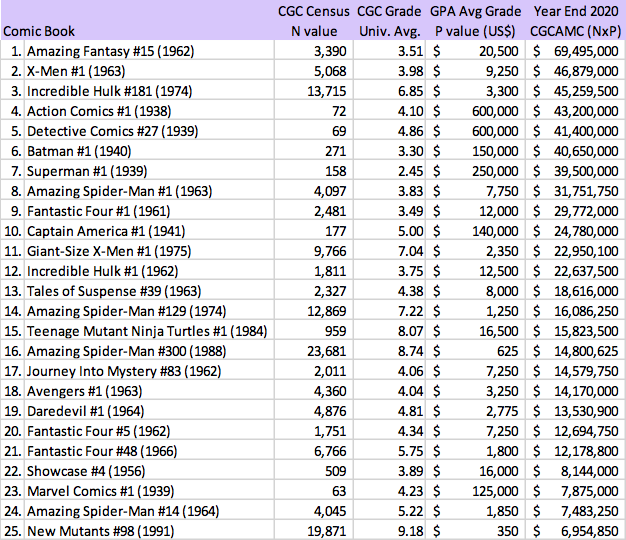
The third article on the topic of CGC Average Market Capitalization (CGCAMC).
The CGC comic book market was significantly impacted by the events of 2020, so much so that the final 2020 list for the Top 25 comic books by CGCAMC calculation is nearly 25% higher than the mid-2020 list. For the first time, Action Comics #1 and Detective Comics #27 are not in the Top 3, replaced by more recent key issues with higher CGC populations. Is this a reflection of a price bubble or a reflection of the books valued more by the market?
Read the complete article on GPAnalysis.com here.
CGC Average Market Capitalization (CGCAMC): 2020 – 2015 – 2010
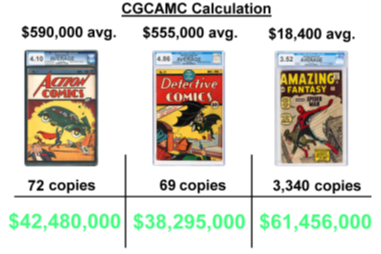
Multiply the average price for the average CGC grade by the number of CGC graded copies and you get CGCAMC – a simple calculation that allows any two comics to be compared on roughly equal footing. Looking back five and ten years, it’s possible to see trends in the market and fascinating to see comic books from the 1980s compete head-to-head against comics from the 1930s. Enjoy multiple Top 25 lists in this month’s article with all the calculations done for you.
Read the complete article on GPAnalysis.com here.
CGC Average Market Capitalization (CGCAMC): An Introduction

When the headlines say, “COMIC BOOK SELLS FOR OVER $3,000,000!” it is certainly an attention-grabber. It is not hard to name the most valuable comic books of all. Do those highest priced comic books truly represent the most total market value for an issue? Would it be better to have 2 copies of a comic worth $100,000 each or 50 copies of a comic worth $5,000 apiece? Don’t worry – the math is already done for you, and the results may be surprising when you see the Top 25 comics calculated with CGCAMC.
Read the full article on GPAnalysis.com.
From Action Comics #1 to early Silver Age – What’s Worth Slabbing in Poor Condition?
This article is Part 4 in a continuing series. Part 1, Part 2, and Part 3 are linked. In previous articles, it was established that books like Amazing Fantasy #15 (1962), Incredible Hulk #1 (1962), and Fantastic Four #1 (1961) – which are submitted to CGC in all conditions – provide a better representation of what conditions might be expected to exist for other comic books of the same age, even if they are never submitted to CGC. Additionally, the percentage of restored books on the CGC Census may be representative of the time period, reflecting attempts to improve a comic’s appearance over the past six decades.
Read the latest article on GPAnalysis.com.
The Early 1960s Beyond Amazing Fantasy #15 (And How Much Restoration?)
In previous articles, it was seen that there is a significant financial incentive to submit even the lowest grade copies of certain books like Amazing Fantasy #15, and the CGC Census grade distributions for Amazing Fantasy #15 are likely to be a good representation of all existing copies of not only Amazing Fantasy #15 but perhaps all 1962 comic books as well. Looking beyond 1962, Fantastic Four #1 (1961) and Avengers #1 (1963) enhance the evidence for the grade distributions of comics books from early 1960s in different ways. How many of these books are CGC 9.0 today? Perhaps just 1%, and the answer to the restoration question might surprise many collectors who never touched their raw books but can’t be too sure about their books’ previous owners 50+ years ago.
Read the full article at GPAnalysis.com
What can the CGC Census tell us about all those ungraded comics?
The CGC Census generally reflects a strong portion of the best copies known, a lighter portion of the existing mid-grade copies, and usually a very small portion of the existing low grade copies. A temptation exists to interpret the CGC Census as representative of both graded and ungraded copies, but the more focused evidence within the CGC Census for specific comics worth grading in all conditions may be applied more broadly to all comic books of the same age. Starting with the CGC Census grades for Amazing Fantasy #15 – a comic absolutely worth submitting to CGC in all conditions.
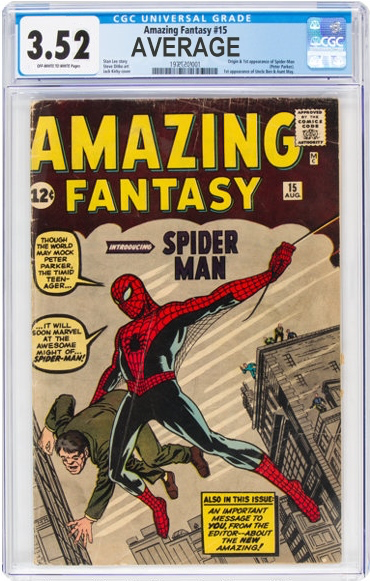
This article provides evidence for the likely grades for all other surviving comic books from 1962, even if the vast majority of those comics are never submitted to CGC. Read the full article from August 27, 2020, on GPAnalysis.com here.
Amazing Spider-Man #300 Direct and Newsstand
Since CGC began grading comic books in 2000, the most submitted book is Amazing Spider-Man #300 (1988). More than 22,000 copies of ASM #300 have been graded as of May 12, 2020.
The current CGC totals and grades for ASM #300 can be found here:
http://www.cgcdata.com/cgc/search/isolateid/273
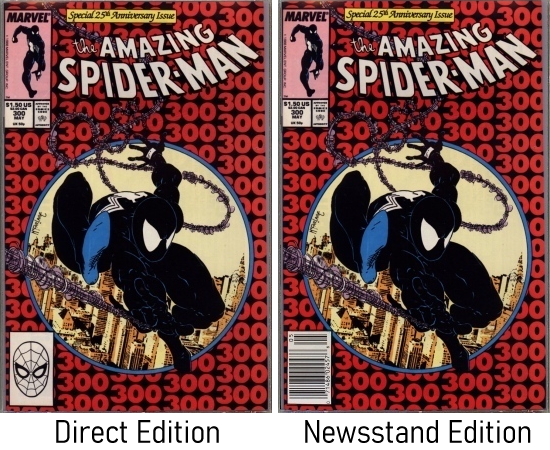
The Direct Edition of ASM #300 was sold to comic book retailers via direct market distributors, having a Spider-Man head on the front cover in the white box on the lower left. Direct editions were sold as non-refundable, in exchange for a discounted price for the retailer. Many dealers ordered extra copies to keep their back issue inventory supplied for years to come.
The Newsstand Edition of ASM #300 with the UPC barcode on the front cover. Newsstand editions of comic books, along with monthly magazines, were most often supplied to locations such as grocery stores, drug stores, gas stations, sandwich shops, and other non-retailer comic shops. Unsold copies of newsstand editions were returned after a month or two for credit, and presumably scrapped, shredded, recycled, or trashed.
More information about Newsstand Editions can be found at Newsstand101.com
As of May 2020, CGC does not differentiate between the Direct Edition and the Newsstand Edition of ASM #300. An evaluation of over 500 copies of ASM #300 in the Ebay.com marketplace on three different dates (January 2016, August 2018, and May 2020) gives a view into the CGC ratios between Direct Edition and Newsstand Edition for ASM #300.
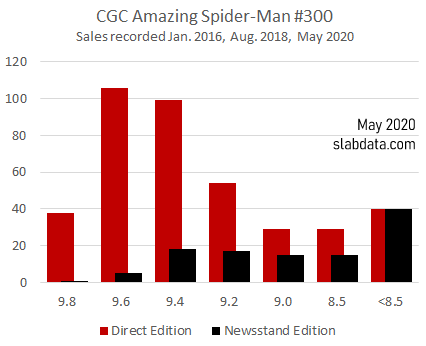
| CGC grade | Direct | Newsstand |
| 9.8 | 38 | 1 |
| 9.6 | 106 | 5 |
| 9.4 | 99 | 18 |
| 9.2 | 54 | 17 |
| 9.0 | 29 | 15 |
| 8.5 | 29 | 15 |
| <8.5 | 40 | 40 |
| TOTAL (506 copies) Average CGC Grade | 395 9.14 | 111 8.36 |
Another view, showing the ratios as X-to-1 for each CGC graded is presented in the graphic below:
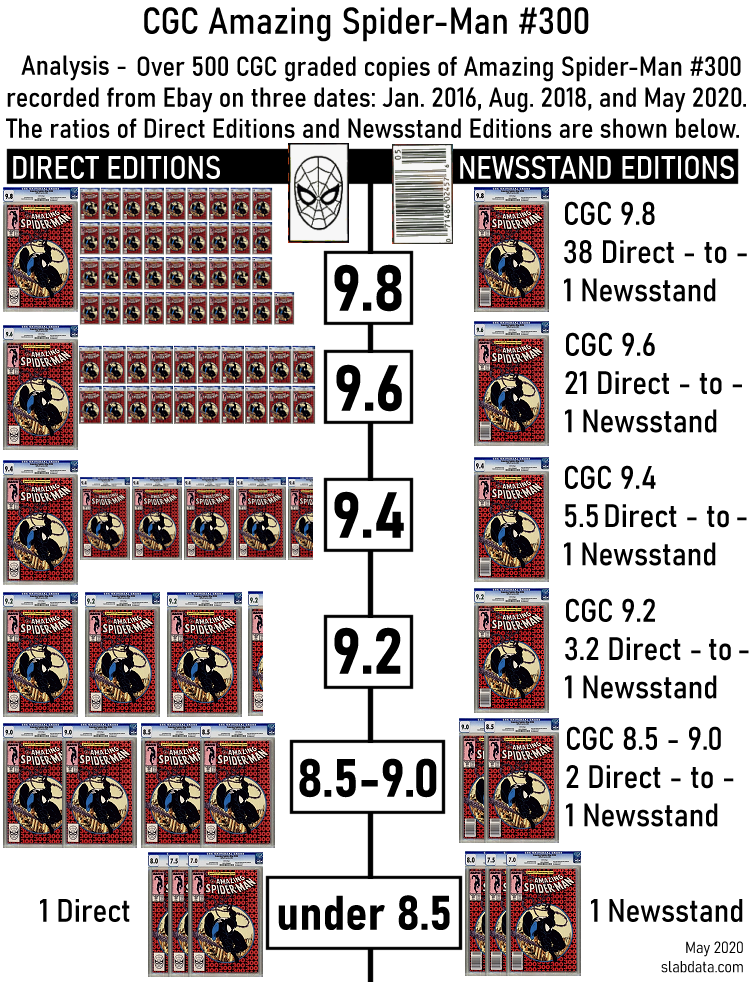
The average CGC grade in the recorded sales for Direct Edition ASM #300 was CGC 9.14, while the average CGC grade for Newsstand Edition ASM #300 was 8.36.
The CGC Census for ASM #300 can be shown with counts for each grade, even though the Direct and Newsstand editions are not separated. The average grade (Universal and Signature Series) is 8.76.
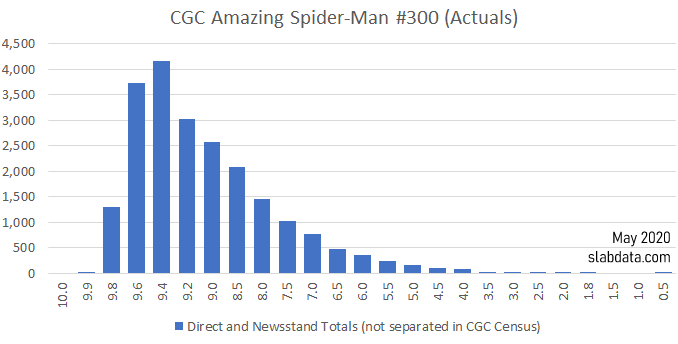
Applying these market ratio estimates to the full CGC Census numbers (22,000+ copies) for ASM #300 results in the following:
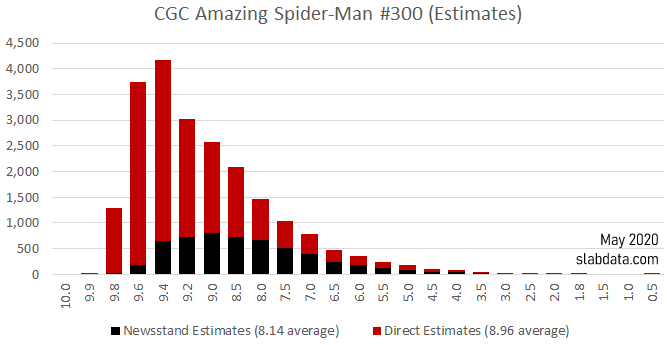
The lower average grade estimates for the full CGC Census (Newsstand 8.14, Direct 8.96) are attributed to the fact that lower grades do not appear in the Ebay.com market as often as the higher grades, relative to their CGC Census totals. Overall, the average grade remains 8.76 for all copies on the census.
CGC Census – Walking Through Time 2000-2020
An interactive data visualization for the first 20 years of CGC grading (2000-2020).
Submissions to CGC by comic in a visualization that steps through the first 20 years of CGC grading. The decades and publishers at the top of the graphic can be selected or de-selected by clicking on the name (such as 1990s Marvel). See how the list changes when you remove the most popular submission decades. The graphic is on a loop, and will restart by itself after 2020 has displayed a few seconds. Use the pause/play button on the bottom left to start and stop the graphic. You can pause and jump directly to any year by clicking on the year in the timeline at the bottom. Then play again to restart.
For the source of this graphic, go to
https://public.flourish.studio/visualisation/1764850/
For a much “taller” version of the graphic (showing 50 comics), go to
https://public.flourish.studio/visualisation/1769671/
CGC Census: Grades For The 1960s
Continuing the thoughts of a previous post, let’s take a moment to focus on the 1960s. Comparing the CGC Census grades (cumulative percentages for Universal and Signature Series), we see a distinct difference between the decade and the most valuable comic book in the decade, Amazing Fantasy #15 (1962).
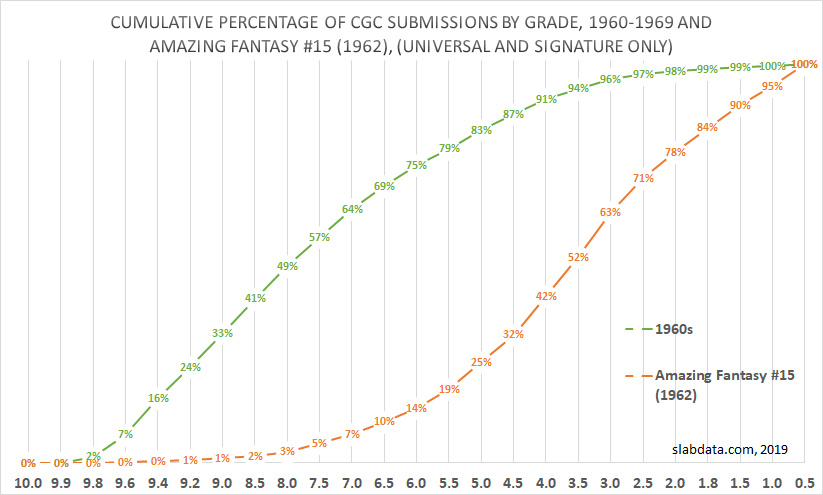
These differences are due to two major factors, first, that books submitted to CGC must (generally) be worth the cost of CGC grading, otherwise, there is no financial reason to submit a book to CGC. As a result, the books submitted to CGC from 1960-1969 have primarily been higher grade copies than average, since value increases as the condition increases. Secondly, the entire decade of the 1960s has been combined to create the 1960s line on the graphic, while Amazing Fantasy #15 represents only a single issue from the single year of 1962.
To remedy these differences, the graphic below represents each year of the 1960s separately, and shows additional comics besides Amazing Fantasy #15 from 1962.
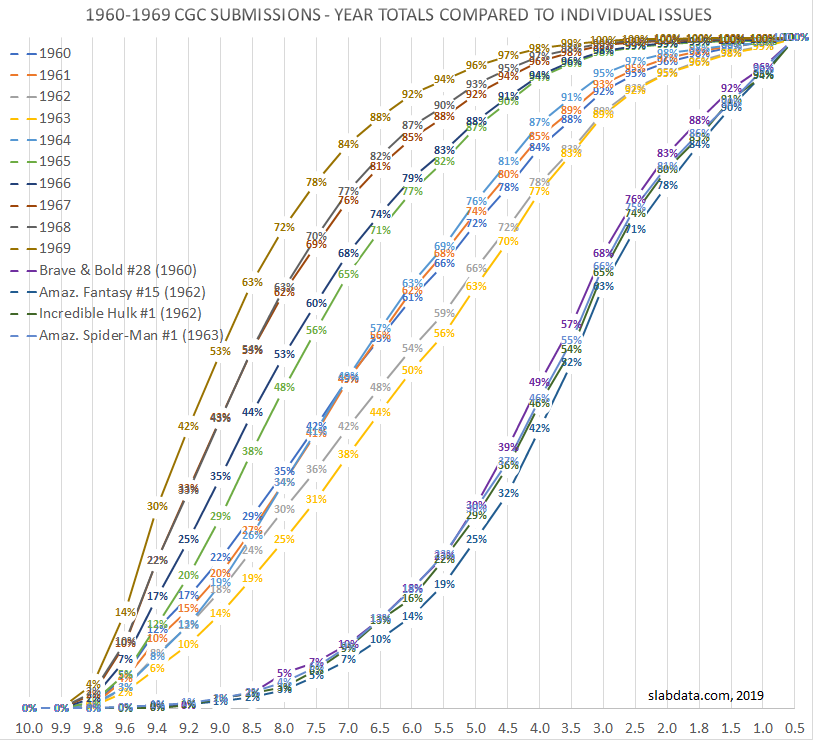
This may be the first time that the consistency of CGC grade percentages has been isolated for major comics of the early 1960s. Because each of these comic books (Brave & The Bold #28, Amazing Fantasy #15, Incredible Hulk #1, and Amazing Spider-Man #1) is generally worth submitting to CGC in all possible grades, these books generally reflect the full populations for each book (percentage-wise), despite every copy not being CGC graded.
While every copy of a comic book is unlikely to be sent to CGC for grading, those comics which are valuable in all grades, including valuable for the difference between CGC 0.5 and CGC 1.0, will be reflected on the CGC Census as a better sample of the total population of comics for that year, or possibly, for several years in that range.
It should be surprising that the four books selected are so closely aligned in their CGC grade percentages, and that they are so far from the percentages of the years they represent. It is possible that these grades may be generally applicable for all comic books of this era, CGC graded or not, even for other comic books of the same age which may have little value.
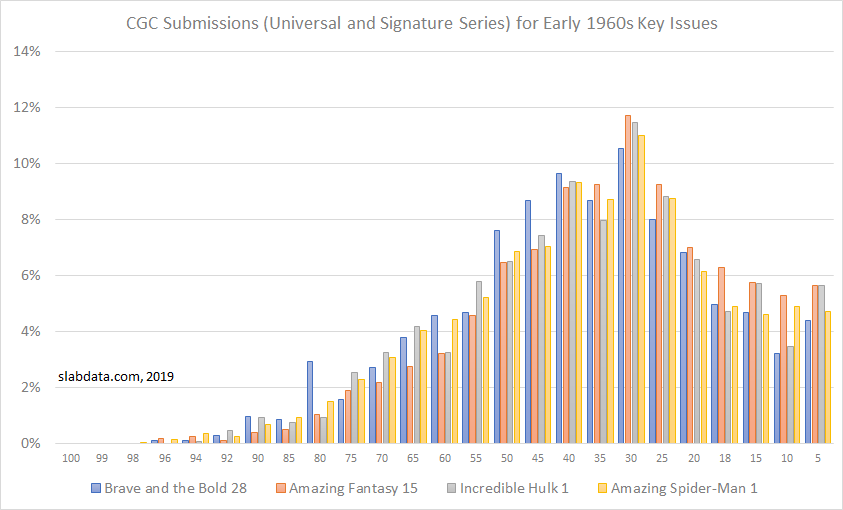
Apart from more CGC 8.0 Brave and the Bold #28 than what might be expected (perhaps due to regrading), is it possible that this general distribution could be applicable to all comics from the early 1960s?
Perhaps time will tell…